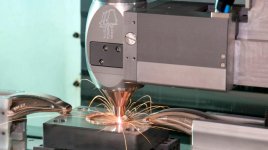RDL
Stainless
- Joined
- Jun 5, 2005
- Location
- Edmonton,Alberta,
Are you familiar with this?
With additive manufacturing, it’s essentially a motion control problem. There are extruders, and you’re melting a powder bed, but it all comes down to control and multiple axes – the same technology that 5-axis machine tools operate.
In the video above, we look at how additive manufacturing technology could be combined with machine-tool technology.
“We had bought a 3D printer some years ago and decided that with our motion platforms, how could we just add a deposition nozzle into a machine tool, and so that’s exactly what we did,” said Jason Jones, PhD, co-founder and CEO of Hybrid Manufacturing Technologies.
The deposition module shown in the video above streams liquid metal, which can be used for additive processes when met with the tool’s laser. As the tool functions the same any other CNC tool, it can be loaded back into the tool magazine and replaced to finish the metal in situ.
Deposition Nozzles for Additive Manufacturing with Standard CNC Machines - YouTube
“Fundamentally, this is a welding process,” explained Jones.
“You need laser energy, feedstock metal powder and shield gas. Those three get delivered and off you go. The most popular materials we use are hard to machine, like Inconel, nickel-based super-alloy materials, steels and cobalt-based materials.”
In the video, Jones demonstrates the repair and remanufacture capabilities that the nozzles can afford with an Inconel propeller from a Cummins diesel engine. Jones presents a model where the tips have been worn off the propeller blades, and a remanufactured comparison where the tips had been effectively recreated using the same material as the base part.
The Hybrid Manufacturing Technologies deposition nozzles are compatible with most machine tool systems, Jones added.
“We work with many machine tool builders, who will buy these heads and integrate them into their machine tools and supply them as new – we power half of the hybrid machine tool models that are available on the market now.”
The deposition nozzles can be retrofitted to existing machines and can be programmed using standard G-code and M-code additions.
For more information, visit the Hybrid Manufacturing Technologies website.
With additive manufacturing, it’s essentially a motion control problem. There are extruders, and you’re melting a powder bed, but it all comes down to control and multiple axes – the same technology that 5-axis machine tools operate.
In the video above, we look at how additive manufacturing technology could be combined with machine-tool technology.
“We had bought a 3D printer some years ago and decided that with our motion platforms, how could we just add a deposition nozzle into a machine tool, and so that’s exactly what we did,” said Jason Jones, PhD, co-founder and CEO of Hybrid Manufacturing Technologies.
The deposition module shown in the video above streams liquid metal, which can be used for additive processes when met with the tool’s laser. As the tool functions the same any other CNC tool, it can be loaded back into the tool magazine and replaced to finish the metal in situ.
Deposition Nozzles for Additive Manufacturing with Standard CNC Machines - YouTube
“Fundamentally, this is a welding process,” explained Jones.
“You need laser energy, feedstock metal powder and shield gas. Those three get delivered and off you go. The most popular materials we use are hard to machine, like Inconel, nickel-based super-alloy materials, steels and cobalt-based materials.”
In the video, Jones demonstrates the repair and remanufacture capabilities that the nozzles can afford with an Inconel propeller from a Cummins diesel engine. Jones presents a model where the tips have been worn off the propeller blades, and a remanufactured comparison where the tips had been effectively recreated using the same material as the base part.
The Hybrid Manufacturing Technologies deposition nozzles are compatible with most machine tool systems, Jones added.
“We work with many machine tool builders, who will buy these heads and integrate them into their machine tools and supply them as new – we power half of the hybrid machine tool models that are available on the market now.”
The deposition nozzles can be retrofitted to existing machines and can be programmed using standard G-code and M-code additions.
For more information, visit the Hybrid Manufacturing Technologies website.



